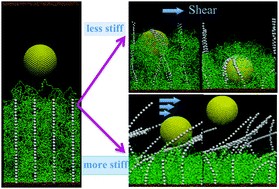Designing a gel–fiber composite to extract nanoparticles from solution†
Abstract
The extraction of nanoscopic particulates from flowing fluids is a vital step in filtration processes, as well as the fabrication of nanocomposites. Inspired by the ability of carnivorous plants to use hair-like filaments to entrap species, we use computational modeling to design a multi-component system that integrates compliant fibers and thermo-responsive gels to extract particles from the surrounding solution. In particular, hydrophobic fibers are embedded in a gel that exhibits a lower critical solution temperature (LCST). With an increase in temperature, the gel collapses to expose fibers that self-assemble into bundles, which act as nanoscale “grippers” that bind the particles and draw them into the underlying gel. By varying the relative stiffness of the fibers, the fiber–particle interaction strength and the shear rate in the solution, we identify optimal parameters where the particles are effectively drawn from the solution and remain firmly bound within the gel layer. Hence, the system can be harnessed in purifying fluids and creating novel hybrid materials that integrate nanoparticles with polymer gels.


 Please wait while we load your content...
Please wait while we load your content...